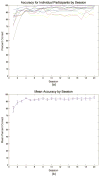Cortical and striatal contributions to automaticity in information-integration categorization
- PMID: 21316475
- PMCID: PMC3085658
- DOI: 10.1016/j.neuroimage.2011.02.011
Cortical and striatal contributions to automaticity in information-integration categorization
Abstract
In information-integration categorization, accuracy is maximized only if information from two or more stimulus components is integrated at some pre-decisional stage. In many cases the optimal strategy is difficult or impossible to describe verbally. Evidence suggests that success in information-integration tasks depends on procedural learning that is mediated largely within the striatum. Although many studies have examined initial information-integration learning, little is known about how automaticity develops in information-integration tasks. To address this issue, each of ten human participants received feedback training on the same information-integration categories for more than 11,000 trials spread over 20 different training sessions. Sessions 2, 4, 10, and 20 were performed inside an MRI scanner. The following results stood out. 1) Automaticity developed between sessions 10 and 20. 2) Pre-automatic performance depended on the putamen, but not on the body and tail of the caudate nucleus. 3) Automatic performance depended only on cortical regions, particularly the supplementary and pre-supplementary motor areas. 4) Feedback processing was mainly associated with deactivations in motor and premotor regions of cortex, and in the ventral lateral prefrontal cortex. 5) The overall effects of practice were consistent with the existing literature on the development of automaticity.
Copyright © 2011 Elsevier Inc. All rights reserved.
Figures





Similar articles
-
Evidence for cortical automaticity in rule-based categorization.J Neurosci. 2010 Oct 20;30(42):14225-34. doi: 10.1523/JNEUROSCI.2393-10.2010. J Neurosci. 2010. PMID: 20962243 Free PMC article.
-
Dissociation between striatal regions while learning to categorize via feedback and via observation.J Cogn Neurosci. 2007 Feb;19(2):249-65. doi: 10.1162/jocn.2007.19.2.249. J Cogn Neurosci. 2007. PMID: 17280514
-
The role of the striatum in visuomotor integration during handwriting: an fMRI study.J Neural Transm (Vienna). 2020 Mar;127(3):331-337. doi: 10.1007/s00702-019-02131-8. Epub 2020 Jan 4. J Neural Transm (Vienna). 2020. PMID: 31901984
-
Corticostriatal circuitry.Dialogues Clin Neurosci. 2016 Mar;18(1):7-21. doi: 10.31887/DCNS.2016.18.1/shaber. Dialogues Clin Neurosci. 2016. PMID: 27069376 Free PMC article. Review.
-
Human and rodent homologies in action control: corticostriatal determinants of goal-directed and habitual action.Neuropsychopharmacology. 2010 Jan;35(1):48-69. doi: 10.1038/npp.2009.131. Neuropsychopharmacology. 2010. PMID: 19776734 Free PMC article. Review.
Cited by
-
Dissociation of category-learning systems via brain potentials.Front Hum Neurosci. 2015 Jul 7;9:389. doi: 10.3389/fnhum.2015.00389. eCollection 2015. Front Hum Neurosci. 2015. PMID: 26217210 Free PMC article.
-
The visual corticostriatal loop through the tail of the caudate: circuitry and function.Front Syst Neurosci. 2013 Dec 6;7:104. doi: 10.3389/fnsys.2013.00104. eCollection 2013. Front Syst Neurosci. 2013. PMID: 24367300 Free PMC article.
-
Procedural-based category learning in patients with Parkinson's disease: impact of category number and category continuity.Front Syst Neurosci. 2014 Feb 19;8:14. doi: 10.3389/fnsys.2014.00014. eCollection 2014. Front Syst Neurosci. 2014. PMID: 24600355 Free PMC article.
-
Frontoparietal networks involved in categorization and item working memory.Neuroimage. 2015 Feb 15;107:146-162. doi: 10.1016/j.neuroimage.2014.11.051. Epub 2014 Dec 4. Neuroimage. 2015. PMID: 25482265 Free PMC article.
-
Toward a dual-learning systems model of speech category learning.Front Psychol. 2014 Jul 31;5:825. doi: 10.3389/fpsyg.2014.00825. eCollection 2014. Front Psychol. 2014. PMID: 25132827 Free PMC article.
References
-
- Anderson JLR, Jenkinson M, Smith SM. Non-linear registration, aka spatial normalisation. FMRIB technical report TR07JA2 2007
-
- Ashby FG, Alfonso-Reese LA, Turken AU, Waldron EM. A neuropsychological theory of multiple systems in category learning. Psychol Rev. 1998;105:442–481. - PubMed
-
- Ashby FG, Boynton G, Lee WW. Categorization response time with multidimensional stimuli. Percept Psychophys. 1994;55:11–27. - PubMed
Publication types
MeSH terms
Grants and funding
LinkOut - more resources
Full Text Sources

